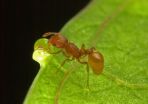(Press-News.org) Disney Research has demonstrated that battery-free, radio frequency identification (RFID) tags can be used to cheaply and unobtrusively determine how people use and interact with daily objects, enabling new types of interactive play, smart homes and work environments, and new methods for studying consumer shopping habits.
RFID tags are designed to simply report an identifying code when energized by an RFID reader, but a Disney Research team directed by Dr. Alanson Sample showed that the radio frequency signals transmitted by these tags provide a unique RF signature which can be used to determine whether a tagged item was being touched or moved.
The researchers found that with their system, called IDSense, they could simultaneously track 20 objects in a room and infer four classes of movements with 93 percent accuracy. They will present their findings at CHI 2015, the Association for Computing Machinery's annual Conference on Human Factors in Computing Systems, April 18-23 in Seoul, South Korea.
"An effective means of identifying people's activities in their homes, schools and workplaces has the potential to enable a wide number of human-computer interaction applications," Sample said. "Whether it's reading a book to a child, cooking a meal or fixing a bicycle, the objects that we use both define and reflect the activities we do in our daily lives."
One common approach has been to attach wireless sensors to objects, he noted, but the size of the sensors, their relatively high cost and the need for battery replacement has limited their applications. RFID tags, by contrast, are commercially available technology, cheap and easy to apply to a wide range of everyday objects.
Sample, along with Disney Research's Can Ye and Hanchuan Li, a Ph.D. student in computer science and engineering at the University of Washington, employed ultra high frequency (UHF) RFID tags, which can return signals up to 10 meters. They found that by observing changes in the signals emitted by the tags - received signal strength indicator (RSSI), radio frequency (RF) phase and Doppler shift - they were able to make inferences about the object to which the tag was attached.
RSSI is a measurement of signal power received at the receiver and is predominantly affected by the distance between the tag and the reader. RF phase - the angle between the carrier signal emitted by the RFID reader and the return signal from the tag - is sensitive to small changes in distance, while the Doppler shift is a radio frequency shift caused by the speed of a moving object.
"The key insight is that these low-level channel parameters represent a snap shot of the RF environment that is unique to each tag," Sample said. "By measuring changes in these signals over time we can infer how someone is interacting with the object."
By using machine learning algorithms, which identify patterns in data, the researchers were able to associate changes in these communication parameters with certain states of the object, such as whether the object was still, whether the object was being rotated or moved, or whether the tag was covered, such as when the object was being held.
The Disney team demonstrated how IDSense could be used by applying RFID tags to stuffed toys, enabling an interactive storytelling game in which rocking or petting a toy lion triggered actions by digital characters. In another demonstration, they used IDSense to monitor 10 commonly used items, such as a drinking glass, a milk container and a cereal box, to show how information about daily living activities could be gathered, and they showed that the tags could be used for studying the browsing behavior of consumers in a retail store.
Other possible applications include detecting occupancy of seats or, in security scenarios, detecting the opening and closing of windows and doors.
INFORMATION:
For more information and a video, please visit the project web site at http://www.disneyresearch.com/publication/idsense-a-human-object-interaction-detection-system-based-on-passive-uhf-rfid.
About Disney Research
Disney Research is a network of research laboratories supporting The Walt Disney Company. Its purpose is to pursue scientific and technological innovation to advance the company's broad media and entertainment efforts. Vice Presidents Jessica Hodgins and Markus Gross manage Disney Research facilities in Los Angeles, Pittsburgh, Zürich, and Boston and work closely with the Pixar and ILM research groups in the San Francisco Bay Area. Research topics include computer graphics, animation, video processing, computer vision, robotics, wireless & mobile computing, human-computer interaction, displays, behavioral economics, and machine learning.
An international team of scientists have put forward a blueprint for a purely space-based system to solve the growing problem of space debris. The proposal, published in Acta Astronautica, combines a super-wide field-of-view telescope, developed by RIKEN's EUSO team, which will be used to detect objects, and a recently developed high-efficiency laser system, the CAN laser that was presented in Nature Photonics in 2013, that will be used to track space debris and remove it from orbit.
Space debris, which is continuously accumulating as a result of human space activities, ...
Half of all patients who survive a cardiac arrest experience problems with cognitive functions such as memory and attention. This has been shown by a major international study led from Lund University. Surprisingly, however, a control group comprising heart attack patients had largely the same level of problems. This suggests that it is not only the cardiac arrest and the consequent lack of oxygen to the brain that is the cause of the patients' difficulties.
The study led by Lund University involved 950 cardiac arrest patients in Europe and Australia. Six months after ...
This news release is available in Japanese.
It seems unnatural that a species could survive without having sex. Yet over the ages, evolution has endowed females of certain species of amphibians, reptiles and fish with the ability to clone themselves, and perpetuate offspring without males. Researchers at the at the Okinawa Institute of Science and Technology Graduate University (OIST) found that in species where females have evolved the ability to reproduce without males relatively recently, fertilization is still ensuring the survival of the maximum number of healthy ...
Scientists at the Vetmeduni Vienna investigated whether stomach ulcers in cattle are related to the presence of certain bacteria. For their study, they analyzed bacteria present in healthy and ulcerated cattle stomachs and found very few differences in microbial diversity. Bacteria therefore appear to play a minor role in the development of ulcers. The microbial diversity present in the stomachs of cattle has now for the first time been published in the journal Veterinary Microbiology.
Gastritis and stomach ulcers in humans are often caused by the bacterium Helicobacter ...
Breast cancer patients often display mild cognitive defects even before the initiation of chemotherapy. A new study by Ludwig-Maximilians-Universitaet (LMU) in Munich researchers now attributes the syndrome to post-traumatic stress induced by diagnosis of the disease.
A large number of studies have shown that cancer patients very often exhibit mild deficits of attention, memory and other basic cognitive functions. The phenomenon has generally been attributed to putative side-effects of chemotherapeutic drugs on the brain, and the condition is therefore popularly referred ...
WASHINGTON --Droperidol is safe and effective for calming violent and aggressive emergency patients, and the negative effects that garnered a black box warning from the Food and Drug Administration (FDA) are actually quite rare. A new study of the once ubiquitous, now scarce, sedating agent was published online Wednesday in Annals of Emergency Medicine ("The Safety and Effectiveness of Droperidol for Sedation of Acute Behavioral Disturbance in the Emergency Department").
"In our study, the two side effects that led to the black box warning - QT prolongation and torsades ...
CLEVELAND -- Anthony J. Furlan, MD, Chairman of Neurology and Co-Director of the Neurological Institute at University Hospitals (UH) Case Medical Center and Case Western Reserve University School of Medicine, who writes an accompanying editorial for five studies about endovascular stroke therapy published simultaneously in the New England Journal of Medicine (NEJM.org April 17), says these randomized clinical trials represent a breakthrough in showing the benefits of endovascular therapy for acute ischemic strokes.
"Now even endovascular skeptics will be convinced," Dr. ...
MANHATTAN, KANSAS -- The key to better cellphones and other rechargeable electronics may be in tiny "sandwiches" made of nanosheets, according to mechanical engineering research from Kansas State University.
Gurpreet Singh, assistant professor of mechanical and nuclear engineering, and his research team are improving rechargeable lithium-ion batteries. The team has focused on the lithium cycling of molybdenum disulfide, or MoS2, sheets, which Singh describes as a "sandwich" of one molybdenum atom between two sulfur atoms.
In the latest research, the team has found ...
The death toll in Cambodia under Khmer Rouge leader Pol Pot was most likely between 1.2 million and 2.8 million -- or between 13 percent and 30 percent of the country's population at the time -- according to a forthcoming article by a UCLA demographer.
April 17 is the 40th anniversary of the Khmer Rouge's capture of the capital of Cambodia -- beginning a four-year period that many consider to be a genocide. For decades, researchers have sought to pinpoint the death toll from political executions, disease, starvation and forced labor inflicted under the Khmer Rouge.
Conventional ...
When the stakes are high, people in positions of low power may perform better by using self-affirmations to boost their confidence, according to new research published by the Society for Personality and Social Psychology.
"Most people have experienced a time in their lives when they aren't performing up to their potential. They take a test or have a performance review at work, but something holds them back," says lead researcher Sonia Kang, Ph.D. "Performance in these situations is closely related to how we are expected to behave."
The researchers conducted three experiments ...


